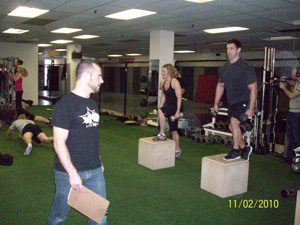Group exercise is a double-edged sword.
On one side it can be made up of highly-efficient workouts that are completely accessible. On the other, we see goofy, inefficient and unnecessarily risky training practices.
Unfortunately it's the latter that most programs subscribe to.
Jazzercise-style leggings may or may be included. The idea of group exercise has been tarnished because of poor understanding of what constitutes a good class.
As coaches and program designers, we have to sidestep the potential pitfalls to create something more than just a consolation prize for people uncomfortable with resistance training. How do you sort out the gold from the dross? The wheat from the chaff?
I'm going to tell you from my perspective:
I run a fitness club in downtown Toronto. My goal from day 1 has been to run an exceptional program. Good wouldn't cut it, it had to be great. You may be interested to know that I never liked group exercise. Yet I still offer it. Here's why:
Group exercise's motivating. There's nothing like a group of people pushing past their own limits to make you bulldoze right through your own. A fun, energetic atmosphere can trump even the best thought-out programming - no matter what the Russian sport scientists will tell you.
Group exercise is about more than just the social environment. It puts the economics of scale to work and is far more affordable than personal training. That's what it takes to make fitness sustainable for a lot of people. You're in the business of helping people so take note.
Although there is a palpable tension between personal trainers and group exercise instructors in many commercial gyms, the truth is that group exercise can be a phenomenal adjunct to an existing personal training program. Philosophies have to jibe, though.
These are some serious positives. Unfortunately, there are also some huge potential drawbacks to group exercise classes. I'm going to offer some advice to ensure that you're delivering the best possible results without getting dragged down in any of the nonsense.
Good classes should:
- Offer a movement continuum: This means that a beginner should be able to work side-by-side with a performance athlete and that any injuries or movement issues are seamlessly accommodated. This is done through to modifying existing exercises to suit skill levels and injury profiles. As an instructor, you should do this automatically. Don't trust your own eye, though, encourage people to approach you with questions or concerns. Have 3 stages of progressions and regressions ready at all times for each exercise.
- Acknowledge that not everyone is ready for group exercise: Although more detail will help you make better-informed decisions, you should perform at least some kind of preliminary screen - even if it's just an inventory of contraindications. This may result in telling someone that they actually need one-to-one instruction or clinical support, even if that means sending them elsewhere. Always remember that you're in the business of helping people.
- Make it clear that it's cool to work at your own level - whatever it may be.
- Make it clear that it's not cool to work at less than your own level: This isn't Tiddlywinks.
- Incorporate a basic knowledge of exercise science: This ranges from properly cueing movement to incorporating logical structuring of exercises. For example, how many bootcamps actually offer a 1:1 ratio of pulling to pushing or bilateral to unilateral movements? This also means having an inverse relationship between technical detail and flat-out effort. In other words, more detailed exercises should be presented early, have less overall volume and longer recovery periods.
- Balance risk with reward: Nobody can burn fat at maximum efficiency if they're nursing a torn ACL or a dislocated shoulder. Your job is to produce long-term results, not short-term gratification.
Running a great class means upping the ante even further. While a great class doesn't need to fulfill all of the following criteria, it should have incorporate least one or two of the features below.
Great classes should:
- A low client-to-trainer ratio: If the instructor is unable to correct every major movement issues as it presents itself, there are simply too many people. Proper ratios can be maintained by capping class sizes or adding assistant instructors. A 5:1 participant to instructor ratio is the maximum ratio you should have.
- Planning: Whenever possible, instructors should assess incoming participants and create a progression that will provide them with exactly the right starting point. This should be followed up by a movement progression based on demonstrated proficiency.
- A beginner stream: There is some basic body awareness and coordination that - in a perfect world - would be a prerequisite for intense group exercise. Helping all beginners develop a base level of competence means that people in other classes will be able to execute on a consistently high level.
- Recovery: While it is often impractical to plan recovery (for reasons outlined in this article), it is possible to monitor for excessive training volume. It's crazy to add to a person's workload when the most effective thing you can do for them is to take away from it.
Industry standards are evolving fast and if Jazzercise feels outdated now, then just wait and see how antiquated today's standards feel five years from now. You're in the business of helping people.
Take responsibility for every one of your class participants results and question every action









